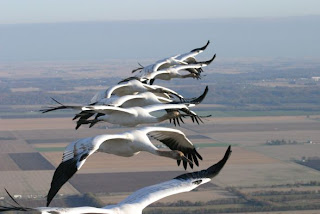 Birds migrate for food and to escape winter. Seasonal migration lets birds avoid cold seasons and exploit food sources available only certain times of the year. Many birds breed in the Arctic and feast on insect swarms there during the brief summer. Come fall, they return home to southlands: southern USA, Central America, or South America. We think of them as "our" birds that go south for the winter but they're really southern birds that fly north to breed.
Birds migrate for food and to escape winter. Seasonal migration lets birds avoid cold seasons and exploit food sources available only certain times of the year. Many birds breed in the Arctic and feast on insect swarms there during the brief summer. Come fall, they return home to southlands: southern USA, Central America, or South America. We think of them as "our" birds that go south for the winter but they're really southern birds that fly north to breed.It’s food scarcity, not dietary preferences, that motivates birds to migrate thousands of miles back and forth between breeding and non-breeding areas each year, new research shows.
“It’s not whether you eat insects, fruit, nectar or candy bars or where you eat them—it matters how reliable that food source is from day-to-day,” said
To figure out the underlying pressures that drive some birds to leave home for the season, said W. Alice Boyle of the University of Arizona. He examined 379 related species of New World flycatchers and compared their size, food type, habitat, migratory behavior and whether or not they fed in flocks.
To compare the birds, the researchers constructed a “supertree” showing the exact evolutionary relationships among different species.
A computer analysis then determined whether a particular species was migratory because it ran in the "family" or whether something in the bird’s environment was forcing it to leave each season.
Boyle and her colleagues found that food scarcity was the number one issue that predicted a species’ migratory behavior.
“Food availability is the underlying process, not diet and habitat,” Boyle said.
An alternative strategy to migrating that the birds used to deal with food scarcity was to forage in flocks, because a group is more likely to find a new patch of food than alone individual.



No comments:
Post a Comment